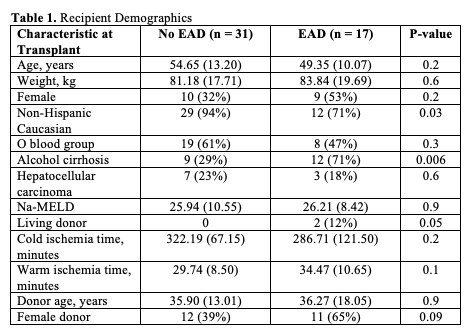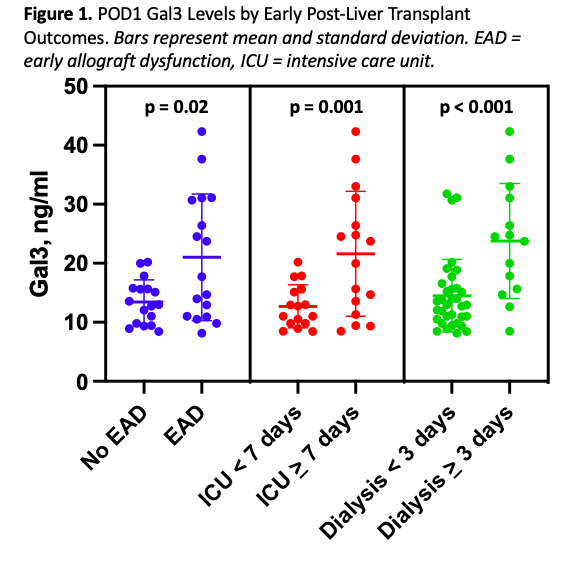Post-Operative Day 1 Galectin-3 is Predictive of Early Allograft Dysfunction in Liver Transplantation
University of Colorado Anschutz Medical, Aurora, CO
Meeting: 2022 American Transplant Congress
Abstract number: 1545
Keywords: Inflammation, Ischemia, Liver, Liver transplantation
Topic: Basic Science » Basic Clinical Science » 17 - Biomarkers: Clinical Outcomes
Session Information
Session Name: Biomarkers: Clinical Outcomes
Session Type: Poster Abstract
Date: Tuesday, June 7, 2022
Session Time: 7:00pm-8:00pm
 Presentation Time: 7:00pm-8:00pm
Presentation Time: 7:00pm-8:00pm
Location: Hynes Halls C & D
*Purpose: Early allograft dysfunction (EAD) is an important outcome measure in liver transplantation that is predictive of graft failure, but the mechanism behind it remains elusive. Galectin-3 (Gal3) is a beta-galactoside binding lectin that plays a key role in inflammation and ischemia-reperfusion injury. The aim of this study was to investigate the association between post-operative day (POD) 1 circulating Gal3 levels and EAD and other early outcome measures post-liver transplant.
*Methods: Citrated plasma was collected from recipients on POD1. Gal3 was measured using standard ELISA. The primary outcomes of interest were EAD, intensive care unit (ICU) length of stay, and post-transplant dialysis. EAD was defined based on post-operative INR, bilirubin, and AST/ALT within 7 days of transplant, as previously described. Continuous data is presented as mean (standard deviation) and compared using two-tailed t-test. Logistic regression was used to assess the predictive power of Gal-3 for EAD.
*Results: 17 of 48 (35%) recipients in the study developed EAD. Recipients with EAD were less commonly non-Hispanic Caucasian and more commonly had alcohol cirrhosis (Table 1). Significantly elevated Gal3 levels were seen among recipients with EAD and those with prolonged ICU length of stay and dialysis requirement (Figure 1). After adjusting for alcohol cirrhosis and race, POD1 Gal3 > 20.17 ng/ml was associated with EAD (OR 14.59, 95% CI 2.03 – 104.56, p = 0.008) and the multivariable model was highly predictive of EAD (AUC = 0.85).
*Conclusions: Gal3 is elevated in liver transplant recipients with longer ICU duration and dialysis requirement, and in combination with diagnosis and race, is highly predictive of EAD. Gal3 may represent a novel therapeutic target to improve early allograft function and recipient outcomes.
To cite this abstract in AMA style:
Yoeli D, Ferrell T, Rodriguez I, Nakra N, Wang Z, Cervantes-Alvarez E, Choudhury R, Adams M, Nydam T, Pomfret E, Huang C, Alvarez NNavarro, Moore H. Post-Operative Day 1 Galectin-3 is Predictive of Early Allograft Dysfunction in Liver Transplantation [abstract]. Am J Transplant. 2022; 22 (suppl 3). https://atcmeetingabstracts.com/abstract/post-operative-day-1-galectin-3-is-predictive-of-early-allograft-dysfunction-in-liver-transplantation/. Accessed December 12, 2025.« Back to 2022 American Transplant Congress


